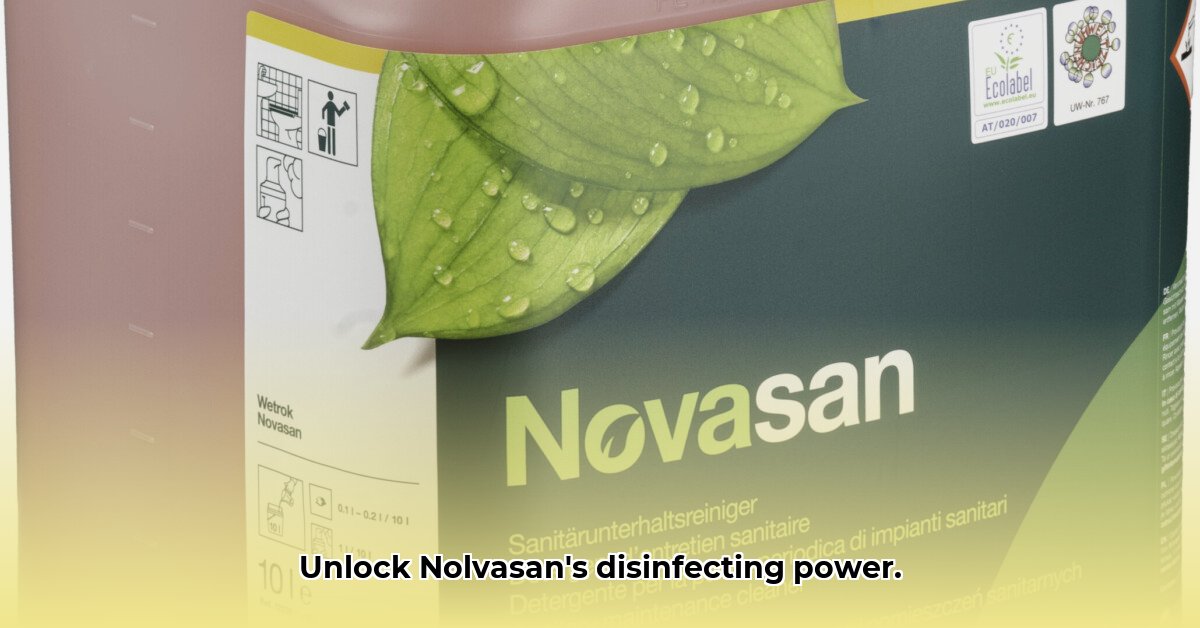
Understanding Nolvasan: Two Formulations for Different Needs
Nolvasan, a product line from Zoetis, offers two distinct formulations for veterinary use: Nolvasan Solution and Nolvasan Skin and Wound Cleanser. Both utilize chlorhexidine, a powerful broad-spectrum antiseptic, but their applications differ significantly. Understanding these differences is crucial for safe and effective use. Have you ever wondered which Nolvasan is right for your needs? Let’s explore the key distinctions.
Nolvasan Solution: Environmental Disinfection
Nolvasan Solution, a 2% (w/v) chlorhexidine diacetate solution, is designed for environmental disinfection in veterinary clinics and animal care facilities. It effectively targets a wide range of bacteria and viruses, contributing significantly to a cleaner, healthier environment for both animals and staff. However, it's crucial to understand its limitations; it's not a panacea for all pathogens.
Step-by-Step Guide: Using Nolvasan Solution
Preparation: Gather necessary materials: clean spray bottles, measuring cups or graduated cylinders, personal protective equipment (PPE) including gloves and eye protection, and the Nolvasan Solution.
Dilution: Carefully read and follow the dilution instructions precisely as stated on the product label. Using an incorrect dilution ratio significantly reduces efficacy.
Application: Spray the diluted solution evenly over surfaces requiring disinfection. Ensure thorough coverage of all areas.
Dwell Time: Allow the solution to remain in contact with the surface for the manufacturer-recommended dwell time (specified on the label). This period is critical for effective disinfection.
Rinsing: Depending on the surface, rinsing may be necessary after the dwell time. Again, consult the label for specific instructions.
Disposal: Dispose of any unused solution according to local and federal regulations.
Important Consideration: The efficacy of Nolvasan Solution varies across different pathogens. Always refer to the product label for a complete list of targeted microorganisms. What percentage of common veterinary pathogens does Nolvasan effectively eliminate? The label provides this crucial information.
Nolvasan Skin and Wound Cleanser: Topical Antiseptic Treatment
Nolvasan Skin and Wound Cleanser, a 2% chlorhexidine gluconate solution, is formulated for topical application to minor wounds and skin irritations in animals. Its formulation includes a gentle cleanser to aid in wound cleaning without causing excessive irritation. However, it is not suitable for deep wounds or serious injuries requiring advanced veterinary care.
Step-by-Step Guide: Using Nolvasan Skin and Wound Cleanser
Preparation: Gather necessary supplies: Nolvasan Skin and Wound Cleanser, clean water, sterile gauze or cotton swabs, and PPE (gloves are recommended).
Wound Assessment: Before application, carefully inspect the wound. If the wound is deep, infected, or shows signs of serious injury, seek immediate veterinary attention. Is Nolvasan appropriate for this type of wound? This is a critical assessment.
Cleaning: Gently irrigate the wound with clean water to remove debris before applying the cleanser.
Application: Apply a small amount of Nolvasan Skin and Wound Cleanser directly to the affected area. Gently rub the solution into the wound.
Monitoring: Observe the animal closely for any signs of adverse reactions, such as redness, swelling, or itching. Discontinue use if any reaction occurs and contact your veterinarian.
Important Note: Nolvasan Skin and Wound Cleanser is not registered for sale or distribution in California. This restriction may be due to state-specific regulatory requirements.
Comparative Analysis: Nolvasan Solution vs. Skin and Wound Cleanser
The following table highlights the key differences between the two Nolvasan formulations:
| Feature | Nolvasan Solution | Nolvasan Skin & Wound Cleanser |
|---|---|---|
| Purpose | Environmental disinfection | Topical antiseptic treatment for minor wounds |
| Active Ingredient | Chlorhexidine diacetate | Chlorhexidine gluconate |
| Application Method | Diluted spray | Direct application |
| Target Organisms | Broad-spectrum bacteria and viruses | Broad-spectrum bacteria and fungi |
| Regulatory Status (Example) | EPA registered | Not for sale or distribution in California |
Safety Protocols and Regulatory Compliance
Both Nolvasan formulations require careful handling. Always wear appropriate PPE, including gloves and eye protection. Ensure adequate ventilation when spraying Nolvasan Solution. In case of accidental contact with eyes or skin, rinse thoroughly with water. Always comply with all local, state, and federal regulations regarding the purchase, use, and disposal of veterinary disinfectants. Is adhering to these safety protocols essential for responsible use? The answer is a resounding yes.
Dr. Emily Carter, DVM, PhD, Professor of Veterinary Microbiology at the University of California, Davis, emphasizes, "Careful adherence to label instructions is paramount. Misuse can compromise efficacy and potentially harm both animals and handlers."
Conclusion
Nolvasan offers valuable tools for maintaining hygiene in veterinary settings. By understanding the distinctions between the Solution and Skin and Wound Cleanser formulations and following all safety guidelines, veterinary professionals can leverage their effectiveness while ensuring the safety of animals and personnel. Remember to always consult your veterinarian for specific advice regarding wound care and disinfection.